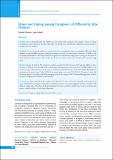Please use this identifier to cite or link to this item:
https://hdl.handle.net/20.500.14356/1038Full metadata record
| DC Field | Value | Language |
|---|---|---|
| dc.contributor.author | Sharma, Sharada | - |
| dc.contributor.author | Subedi, Jaya | - |
| dc.date.accessioned | 2023-04-20T07:36:21Z | - |
| dc.date.available | 2023-04-20T07:36:21Z | - |
| dc.date.issued | 2022 | - |
| dc.identifier.citation | SharmaS., & SubediJ. (2022). Stress and Coping among Caregivers of Differently Able Children. Journal of Nepal Health Research Council, 20(01), 186-193. https://doi.org/10.33314/jnhrc.v20i01.4069 | en_US |
| dc.identifier.issn | Print ISSN: 1727-5482; Online ISSN: 1999-6217 | - |
| dc.identifier.uri | http://103.69.126.140:8080/handle/20.500.14356/1038 | - |
| dc.description | Original Article | en_US |
| dc.description.abstract | Abstract Background: Caring differently able children can cause stress in the caregivers. They employ a variety of coping mechanisms to deal with stress. The aim of this study is to identify stress and different coping styles among caregivers of differently able children. Methods: A cross-sectional study was carried out in three organizations that accommodated differently abled children. A non-probability purposive sampling technique was used to recruit primary caregivers of children with developmental disabilities. This study examined caregiver stress and different coping styles by using the Parent Stress Scale and Brief COPE Inventory. Face-to-face interviews were used to collect data, which was then analyzed using SPSS. Results: Among the total of 102 caregivers, mothers accounted for 60.8 percent, 57.8 percent child were boys whereas, 49 percent were the child with cerebral palsy. Total mean stress score was 57.17 ±8.808. High level of stress was reported by 58.8 percent of caregivers. Education and family income showed the statistically significant association with stress score P-value<0.05. Total mean coping score was 67.83 ±5.812. Caregivers’ stress had significant positive correlation with different coping styles; active coping, denial, behavioral disengagement, humor, acceptance religion and self-blame (P-value<0.05). Conclusions: More than half of the caregivers had high level of stress. The most frequently used coping styles were self-distraction, acceptance and positive reframing. Caregivers’ stress had significant positive correlation with different coping styles. Therefore, health professionals and service providers should focus on stress reduction and positive coping technique to help family adaptation. Keywords: Caregiver; coping; differently able children; stress. | en_US |
| dc.language.iso | en | en_US |
| dc.publisher | Nepal Health Research Council | en_US |
| dc.relation.ispartofseries | Jan-March, 2022;4069 | - |
| dc.subject | Caregiver | en_US |
| dc.subject | coping | en_US |
| dc.subject | differently able children | en_US |
| dc.subject | stress | en_US |
| dc.title | Stress and Coping among Caregivers of Differently Able Children | en_US |
| dc.type | Journal Article | en_US |
| local.journal.category | Original Article | - |
| Appears in Collections: | Vol. 20 No. 01 (2022): Issue 54 Jan-March, 2022 | |
Files in This Item:
| File | Description | Size | Format | |
|---|---|---|---|---|
| 4069-Manuscript-27891-1-10-20220606.pdf | Fulltext Download | 265.88 kB | Adobe PDF |  View/Open |
Items in DSpace are protected by copyright, with all rights reserved, unless otherwise indicated.
